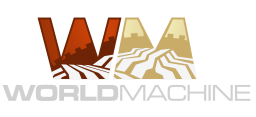Force an input terrain or image to take on constant values within repeating “cells”.
When to Use
This device is useful for both realistic and stylized purposes. For example, you can use Crystallize to simulate the distinctive look of columnar basalt outcroppings. You could also superimpose hex cells for a board game map (see below).
How to Use
Connect a terrain or image to the primary input. By default, the entire map is converted to hexes/squares; if you supply a mask input, you can control exactly where the hexes will appear.

Inputs
Cellular Sample (optional): If supplied, the elevation of the cell will be taken from this input instead of the primary one. This is useful if you want to give the cells values that are somehow different (smoother, higher, etc) from the terrain that the result is blended into.
Mask: The provided mask will be modified by the cell structure if “Apply mask to full cell” is checked (the default).
Outputs
- Cell ID: A random value assigned to each cell of the map
- Mask: The mask input, modified by the structure of the cells. This will be all-white if no mask was supplied.
- Borders: A mask indicating the borders of the cells. Useful for texturing and other special purposes.
Parameters
- Cell Shape: Choose Hexagonal or square tiles
- Size: How large the cells are (diameter)
- Apply mask to full cell: When a mask input is supplied, this forces cells to be either fully present or not at all.
- Height Percentage: Constrain the height of the crystals to be a multiple of the cell diameter. A value of 0 does not constrain the cell height. Values larger than 1 are possible.
Tips and Tricks

- When used for realistic purposes, connecting distortion to the placement input gives a pleasing amount of variation to the basic grid.
- You can use the “Cell ID” output to generate unique and interesting patterns, especially when using distortion.
- You can use the rotation control to adjust the heading of the cells
Limitations
Further options will become available at a later time.

Could you include images in these posts?
The original help article includes images, but the excerpts and show original button here don’t. I’m not sure why; something to do with the discourse plugin. I’d recommend reading the articles on the actual site, and using the companion forum article for questions and feedback.